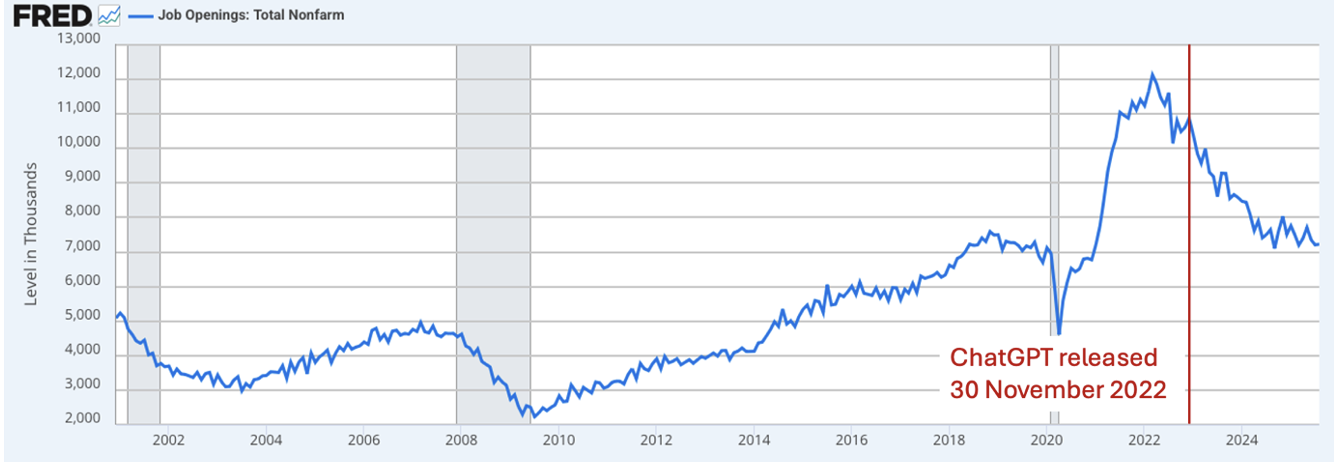
Is artificial intelligence stealing jobs?
On November 30, 2022, the world marvelled at the release and conversational prowess of OpenAI’s ChatGPT. What the world might have missed, however, was the subtle shift that began rippling through the U.S. economy.
What started as a viral tech demo – capable of drafting emails, coding snippets, and even poetry – escalated into a full-blown revolution in large language models (LLMs) and artificial intelligence, now described as the fourth industrial revolution.
Figure 1. Total U.S. non-farm job openings. CHATGPT’s release

Source: U.S Bureau of Labor Statistics via FRED
Fast-forward to October 2025, and the U.S. Bureau of Labour Statistics (BLS) reports that total nonfarm job openings have stabilised at 7.23 million. While that’s a modest uptick from July’s 7.208 million, it’s still a far cry from the peak of over 12 million in early 2022.
The precipitous decline in hiring demand aligns eerily with the dawn of generative AI. Is there a valid link? Is this a mere coincidence, or the first tremors of AI’s long-feared killer blow to the labour market?
To understand the decline, we need to rewind to the pandemic. Remember, the “Great Resignation” of 2021-2022 that saw workers quitting en masse, leaving employers scrambling to fill vacancies?
Thanks to that Great Resignation, by March 2022, the Job Openings and Labour Turnover Survey (JOLTS) data showed record job openings. A frantic scramble for employees ensued, driving wages higher and fuelling inflation.
Then, in November that year, ChatGPT launched to the public, and suddenly, tools automating routine cognitive tasks ceased being the subject of science fiction. Within months, job openings began their slide. From a peak of just over 12 million in February 2023, they plummeted to 8.1 million by mid-2023, and have hovered in the 7-8 million range ever since.
By August 2025, the figure stood at 7.23 million – an increase of just 19,000 from the prior month, but down over 40 per cent from the peak.
Economists, however, point to cooling inflation, higher interest rates, and a post-pandemic normalisation as explanations for the drop in job openings, but the coincidence with AI’s release and spread understandably raises important questions, because just as the Federal Reserve hiked rates to tame prices, businesses didn’t merely pause hiring – they started rethinking roles altogether.
Remember AI promises efficiency gains without the payroll, potentially turning what might have been a cyclical or temporary slowdown into a structural one.
ChatGPT
ChatGPT wasn’t the first LLM, but it was the one that amassed 100 million users in two months after its release on November 30, 2022.
Suddenly, marketers could generate ad copy, developers could debug code via prompts, and HR teams could screen resumes with algorithmic precision. The result? Today’s explosion in AI investment.
Venture capital poured into startups building on LLMs, while incumbents like Microsoft and Google integrated generative AI into their suites. By 2023, McKinsey estimated that AI could automate activities taking up to 30 per cent of hours worked in the U.S. economy. PwC’s 2025 Global AI Jobs Barometer, analysing a billion job ads, found that AI-exposed sectors saw posting volumes drop by up to 20 per cent year-over-year in 2024-2025, as companies leaned on tools like ChatGPT to handle tasks previously outsourced to people.
Entry-level positions, often the proving ground for young talent, have become the prime target. A Stanford study from August 2025 labelled these roles “canaries in the coal mine”, revealing a decline in relative employment for the most AI-exposed roles among workers aged 22-25. Overall employment for this cohort in high-exposure fields declined by 6 per cent, with programmers experiencing a 20 per cent decrease in demand since the debut of ChatGPT.
Sceptics argue the labour market remains resilient. And it’s true that there are no mass layoffs. U.S. unemployment is steady at around 4.2 per cent this calendar year, and a Yale study released just days ago has found “no discernible disruption” in broader employment metrics 33 months after the release of ChatGPT.
But zoom in on roles more vulnerable to AI, and the picture changes dramatically.
Take tech: Hiring announcements cratered 58 per cent in 2025 compared to 2024, with only 5,510 jobs posted versus 13,263 a year earlier. The St. Louis Fed’s analysis shows occupations with high AI exposure – like data entry, customer service, and basic coding – experienced unemployment spikes of 1-2 percentage, materially outpacing sectors with less exposure.
So serious is the shift that the U.S. Bureau of Labour Statistics (BLS) projections now incorporate AI explicitly. Credit analysts, for instance, face a 3.9 per cent employment drop from 2023-2033 due to automated risk assessments.
Elsewhere, a CBS-reported study highlights early-career workers hit hardest: a 13 per cent employment drop in AI-exposed sectors for those under 25, versus stability for older workers. Confirming this finding, MIT research concludes that current AI tools augment experts while sidelining novices. In coding, for example, senior developers thrive with AI copilots, but juniors struggle as firms hire fewer people to train.
Clearly, there’s an AI-induced jobs squeeze, but its effects are uneven. Nevertheless, it’s estimated that 30 per cent of U.S. jobs are at risk from automation by 2030. The outlook could become much more brutal if left unchecked.
The picture offered by Figure 1., is not yet proof of doom, but it is a harbinger, or a shot across the bow of those investors who are optimistic about economies avoiding a jobs recession. If that happens, many will say ChatGPT single-handedly tanked hiring. In reality, what it did is amplify pre-existing pressures, by giving firms tools to do more with less at a vulnerable moment. For young workers and those with routine tasks, the pain is becoming very real and immediate. One thing’s clear: The AI genie is out of the bottle, and it’s rewriting job boards in real time.
Disclaimer:
The Polen Capital Global Growth Fund owns shares in Alphabet, and Microsoft. This article was prepared 7 October 2025 with the information we have today, and our view may change. It does not constitute formal advice or professional investment advice. If you wish to trade any of these companies you should seek financial advice.